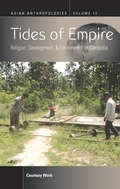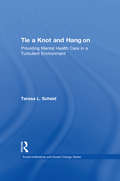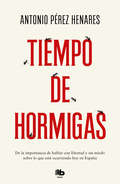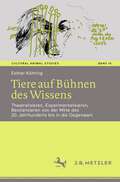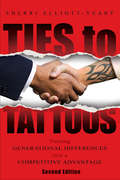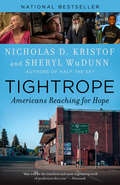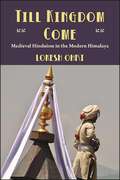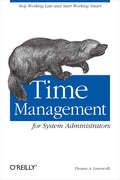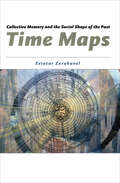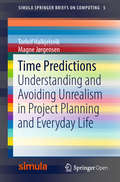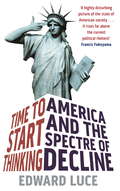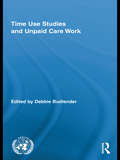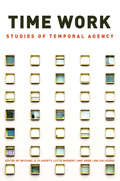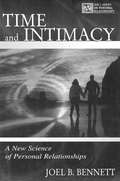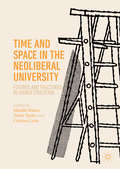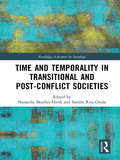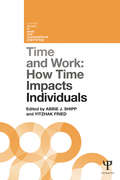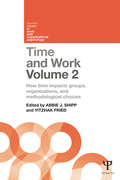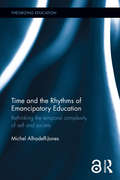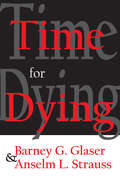- Table View
- List View
Tides of Consent
by James A. StimsonPolitics is a trial in which those in government - and those who aspire to be - make proposals, debate alternatives, and pass laws. Then the jury of public opinion decides. It likes the proposals or actions or it does not. It trusts the actors or it doesn't. It moves, always at the margin, and then those who benefit from the movement are declared winners. This book is about that public opinion response. Its most basic premise is that although pubic opinion rarely matters in a democracy, public opinion change is the exception. Public opinion rarely matters, because the public rarely cares enough to act on its concerns or preferences. Change happens only when the threshold of normal public inattention is crossed. When public opinion changes, governments rise or fall, elections are won or lost, old realities give way to new demands.
Tides of Empire: Religion, Development, and Environment in Cambodia (Asian Anthropologies #10)
by Courtney WorkAt the forested edge of Cambodia’s development frontier, the infrastructures of global development engulf the land and existing social practices like an incoming tide. Cambodia’s distinctive history of imperial surge and rupture makes it easier to see the remains of earlier tides, which are embedded in the physical landscape, and also floating about in the solidifying boundaries of religious, economic, and political classifications. Using stories from the hybrid population of settler-farmers, loggers, and soldiers, all cutting new social realities from the water and the land, this book illuminates the contradictions and continuities in what the author suggests is the final tide of empire.
Tie a Knot and Hang on: Providing Mental Health Care in a Turbulent Environment
by Teresa ScheidTie a Knot and Hang On is an analysis of mental health care work that crosses the borders of diverse sociological traditions. The work seeks to understand the theoretical and empirical linkages between environmental pressures and activities and how these intersect with organizations and individuals. The work draws upon a research tradition that sees the issue of mental health care in terms of institutional pressures and normative values. The author provides a description and a sociological analysis of mental health care work, emphasizing the interaction of professionally generated norms that guide the "emotional labor" of mental health care workers, and the organizational contexts within which mental health care is provided. She concludes with a discussion of emerging institutional forces that will shape the mental health care system in the future. These forces are having greater impact than ever before as managed care comes to have a huge fiscal as well as institutional impact on the work of mental health professionals. Scheid's book is a brilliant, nuanced effort to explain the institutional demands for efficiency and cost containment with the professional ethics that emphasize quality care for the individual. The book is essential reading for those interested in mental health care organizations and the providers responding to these seemingly larger, abstract demands. The work offers a rich mixture not just of the problems faced by mental health care personnel, but the equilibrium currently in place u an equilibrium that shapes the theory of the field, no less than the activities of its practitioners. Teresa L. Scheid is associate professor of sociology, at the University of North Carolina at Charlotte. She has published widely in the area, including major essays in Sociology of Health and Illness, Sociological Quarterly, Perspectives on Social Problems, and The Journal of Applied Behavioral Science.
Tiempo de hormigas
by Antonio Pérez HenaresUn libro de alto voltaje político sobre la encrucijada histórica y social en la que se encuentra España. Antonio Pérez Henares es célebre por la claridad de sus ideas, así como por expresarlas con franqueza y sin andarse con rodeos. En este libro pone encima de la mesa las grandes cuestiones –y grandes tabúes– que preocupan a millones de personas en nuestro país como la manipulación acerca de la historia de España, el paso del feminismo al «hembrismo», la crisis de la verdad en el periodismo, la «progrecracia» o la ecología animalista... Tiempo de hormigas abre un debate sin censura sobre asuntos urgentes, invitándonos a la reflexión, a la vez que realiza un ataque frontal y fulminante contra el «neototalitarismo». «Pues la libertad, "el más preciado bien" en cervantino decir, o es de todos y a todos ampara, o simplemente no existe, no es. Ejerceré, pues, la mía.» La crítica ha dicho:«Entre Ken Follett y Pascal Picq, un gigante del periodismo español como Pérez Henares se ha inventado un nuevo género: la novela policíaca de las cavernas.»Le Point, sobre La canción del bisonte «¿Y si la Prehistoria fue la verdadera Edad de Oro de la humanidad? Una novela que no dejará indiferente a nadie. Reveladora.»Juan Luis Arsuaga, sobre La canción del bisonte «Una aventura fascinante, de principio a fin y de mar a mar, por la inmensidad de una América desconocida y salvaje.»Isabel San Sebastián, sobre Cabeza de Vaca «Mucho más que una novela: la epopeya de uno de nuestros héroes ignorados, contada por un gran autor que ha seguido sus pasos.»Juan Eslava Galán, sobre Cabeza de Vaca
Tiere auf Bühnen des Wissens: Theatralisieren, Experimentalisieren, Bestiarisieren von der Mitte des 20. Jahrhunderts bis in die Gegenwart (Cultural Animal Studies #19)
by Esther KöhringVon Becketts Bühnenmensch über Beuys’ Kojoten und Rosenthals Others bis zu Baehrs Bestiarium und vielen weiteren Bühnen- und Theatertieren: Welche Fragen werden an und mit Tieren auf den Bühnen gestellt? Das Buch untersucht die Kreuzungspunkte zwischen den Wissensorten Theaterbühne, Tierexperiment, Tiertheorie und Theatertheorie in systematischer wie historischer Hinsicht sowie mit epistemologischen, ästhetischen und ethischen Perspektivierungen. Es zeigt, wie das Konzept Theatralität und die Figuration Tier einander konstituieren und unternimmt eine Archäologie des animal turn, der Konjunkturen von Tieren auf Bühnen und ihrer Wahrnehmung in der Kulturwissenschaft.
Ties to Tattoos: Turning Generational Differences into a Competitive Advantage (Ties To Tattoos 2nd Edition Ser.)
by Sherri Elliott-Yeary“Capitalizing on the talents of a multigenerational work force is the key to future business success. Sherri Elliott recognizes that and gives sound advice.” —Leslie Elliott, president, Toni & Guy, USAFor the first time in history, the American workforce is comprised of four distinct generations—Traditionalists, Boomers, Xers, and Millennials. Additionally, today’s workforce brings with it a new set of challenges and opportunities: the looming labor shortage, sagging productivity, knowledge transfer, the language barrier, and stereotypes.Ties to Tattoos offers innovative ways to recruit, reward, manage, motivate, train, and retain, all within a generationally diverse workplace. Understanding generational issues is one of the best new tools for resolving conflicts and boosting productivity. Ties to Tattoos provides keys for understanding these issues and strategies to leverage multigenerational differences in ways that make companies stronger. The creative people strategies described throughout the book set the bar for companies in the coming decade with the sustainable competitive advantage engaged and committed employees.“Ties to Tattoos provides thought-provoking realities you need to consider. It affords actionable ideas on how to gain better understanding of what drives today’s workforce to deliver exceptional results.” —George Killebrew, Senior Vice-President of Corporate Sponsorships, Dallas Mavericks“Provides very helpful insights into the nature and reasons for these generational differences and offers strategies for leveraging them to an organization’s advantage. While the commonalities between generations may be much greater than the differences, knowing how to recognize and manage the differences can make the leadership challenge less daunting.” —Susan R. Meisinger, SPHR, past president, Society for Human Resource Management
Tightrope: Americans Reaching for Hope
by Nicholas D. Kristof Sheryl WuDunnNATIONAL BESTSELLER • With stark poignancy and political dispassion Tightrope addresses the crisis in working-class America while focusing on solutions to mend a half century of governmental failure. This must-read book from the authors of Half the Sky &“shows how we can and must do better&” (Katie Couric)."A deft and uniquely credible exploration of rural America, and of other left-behind pockets of our country. One of the most important books I've read on the state of our disunion."—Tara Westover, author of Educated Drawing us deep into an &“other America,&” the authors tell this story, in part, through the lives of some of the people with whom Kristof grew up, in rural Yamhill, Oregon. It&’s an area that prospered for much of the twentieth century but has been devastated in the last few decades as blue-collar jobs disappeared. About a quarter of the children on Kristof&’s old school bus died in adulthood from drugs, alcohol, suicide, or reckless accidents. While these particular stories unfolded in one corner of the country, they are representative of many places the authors write about, ranging from the Dakotas and Oklahoma to New York and Virginia. With their superb, nuanced reportage, Kristof and WuDunn have given us a book that is both riveting and impossible to ignore.
Till Kingdom Come: Medieval Hinduism in the Modern Himalaya
by Lokesh OhriThe first book to offer a detailed framework, a fine-grained history, and an analytically nuanced understanding of one of the rarest branches of Hindu worship.Hinduism, as is well known, has taken a multitude of shapes and forms. Some Hindu "little traditions" have remained obscure or understudied to this day due to their regional remoteness. One such offshoot is the influential cult of Mahasu, which has existed since medieval times in a part of the western Himalaya. The deity at the core of the cult takes the form of four primary Mahasus with territorial influence, installed in various far-flung temples. Their geographical center is the village of Hanol, and the larger territory is integrated into the Mahasu politico-religious system by a peripatetic deity with loyal followers across a considerable domain.Mahasu remains influential in the region, its ritual practices having remained quite distinct despite social change. An anthropological survey was conducted in its terrain during British times, but Till Kingdom Come is the first book to offer a detailed framework, a fine-grained history, and an analytically nuanced understanding of one of the rarest branches of Hindu worship.
Time Management for New Employees
by Prakash V. RaoEffective time management directs and focuses raw talent and skill in a way that delivers results. It not only encourages responsibility, but also facilitates creativity, helping you to successfully negotiate every aspect of your role so that you can optimize the value of every action you take at work. Time Management for New Employees will provide you with guidelines, strategies, and instructions to master this skill. You will learn how to set and manage expectations, how to prioritize activities, capitalize on your strengths and delegate effectively, how to meet deadlines, how to avoid interruptions and distractions, and how to manage your schedule without getting overwhelmed. Find out how to align your long term goals with your day to day activities, and learn how to derive maximum value from all your activities, to ensure your time is never wasted. Learn how to successfully plan your time, and find out how to prioritize and delegate tasks in a way that is focused on delivering a quality end result. Make sure you never miss another deadline, master interruptions and disasters, and make effective time management a key component of your professional development and success. With practical strategies and exercises created to make time management simple, and metrics to help you develop and improve, Time Management for New Employees is a valuable resource for anyone that wants to make an impact in their new role.
Time Management for System Administrators: Stop Working Late and Start Working Smart
by Thomas A. LimoncelliTime is a precious commodity, especially if you're a system administrator. No other job pulls people in so many directions at once. Users interrupt you constantly with requests, preventing you from getting anything done. Your managers want you to get long-term projects done but flood you with requests for quick-fixes that prevent you from ever getting to those long-term projects. But the pressure is on you to produce and it only increases with time. What do you do?The answer is time management. And not just any time management theory--you want Time Management for System Administrators, to be exact. With keen insights into the challenges you face as a sys admin, bestselling author Thomas Limoncelli has put together a collection of tips and techniques that will help you cultivate the time management skills you need to flourish as a system administrator.Time Management for System Administrators understands that an Sys Admin often has competing goals: the concurrent responsibilities of working on large projects and taking care of a user's needs. That's why it focuses on strategies that help you work through daily tasks, yet still allow you to handle critical situations that inevitably arise.Among other skills, you'll learn how to:Manage interruptionsEliminate timewastersKeep an effective calendarDevelop routines for things that occur regularlyUse your brain only for what you're currently working onPrioritize based on customer expectationsDocument and automate processes for faster executionWhat's more, the book doesn't confine itself to just the work environment, either. It also offers tips on how to apply these time management tools to your social life. It's the first step to a more productive, happier you.
Time Maps: Collective Memory and the Social Shape of the Past (The\other Voice In Early Modern Europe Ser.)
by Eviatar ZerubavelThe pioneering sociologist and author of The Seven Day Circle continues his analysis of time with this fascinating look at history as social construct. Who were the first people to inhabit North America? Does the West Bank belong to the Arabs or the Jews? Why are racists so obsessed with origins? Is a seventh cousin still a cousin? Why do some societies name their children after dead ancestors? As Eviatar Zerubavel demonstrates in Time Maps, we cannot answer burning questions such as these without a deeper understanding of how we envision the past. In a pioneering attempt to map the structure of collective memory, Zerubavel considers the cognitive patterns we use to organize the past and the social grammar of conflicting interpretations of history. Drawing on fascinating examples that range from Hiroshima to the Holocaust, and from ancient Egypt to the former Yugoslavia, Zerubavel shows how we construct historical origins; how we tie discontinuous events together into stories; how we link families and entire nations through genealogies; and how we separate distinct historical periods from one another through watersheds, such as the invention of fire or the fall of the Berlin Wall. "Time Maps extends beyond all of the old clichés about linear, circular, and spiral patterns of historical process and provides us with models of the actual legends used to map history…brilliant and elegant."-Hayden White, University of California, Santa Cruz
Time Predictions: Understanding And Avoiding Unrealism In Project Planning And Everyday Life (Simula Springerbriefs On Computing Ser. #5)
by Torleif Halkjelsvik Magne JørgensenThis book is published open access under a CC BY 4.0 license.Predicting the time needed to complete a project, task or daily activity can be difficult and people frequently underestimate how long an activity will take. This book sheds light on why and when this happens, what we should do to avoid it and how to give more realistic time predictions. It describes methods for predicting time usage in situations with high uncertainty, explains why two plus two is usually more than four in time prediction contexts, reports on research on time prediction biases, and summarizes the evidence in support of different time prediction methods and principles. Based on a comprehensive review of the research, it is the first book summarizing what we know about judgment-based time predictions. Large parts of the book are directed toward people wishing to achieve better time predictions in their professional life, such as project managers, graphic designers, architects, engineers, film producers, consultants, software developers, or anyone else in need of realistic time usage predictions. It is also of benefit to those with a general interest in judgment and decision-making or those who want to improve their ability to predict and plan ahead in daily life.
Time Series Prediction: Forecasting The Future And Understanding The Past
by Andreas S. WeigendThe book is a summary of a time series forecasting competition that was held a number of years ago. It aims to provide a snapshot of the range of new techniques that are used to study time series, both as a reference for experts and as a guide for novices.
Time To Start Thinking: America and the Spectre of Decline
by Edward LuceOn its present course, the US faces a world of rising new countries that will compete with it ever more fiecely as its own power is declining. In order to slow and improve this steady leakage of power, the US must change course internationally, economically and domestically. It must also restructure to remain the world's most competitive economy. And it must address quality of life issues and fairness at home. But American politics is broken -- competing forces and interests have led to stasis. With change so tough, where now for a country where the middle classes are suffering as they have never suffered before, the pensions crisis is growing, the deficit out of sight, and radicalism waiting in the wings?
Time Use Studies and Unpaid Care Work (Routledge/UNRISD Research in Gender and Development)
by Debbie BudlenderAcross the world, unpaid care work - unpaid housework, care of persons, and "volunteer" work - is done predominantly by women. This book presents and compares unpaid care work patterns in seven different countries. It analyzes data drawn from large-scale time use surveys carried out under the auspices of the United Nations Research Institute for Social Development (UNRISD). With its in-depth concentration on time use patterns in developing nations, this book will offer many new insights for scholars of gender and care.
Time Use in Domestic Settings Throughout the Life Course: The Italian Case (Springerbriefs In Sociology)
by Giulia Maria Dotti SaniThe volume is the first to take a life-course approach to the study of domestic work in Italy. It provides a coherent and systemic overview of time spent on housework, childcare and adult care over the life course. While most previous research has focused on the time adult women and men spend on housework and the division of domestic chores among partners, this unique contribution studies the amount of time spent on chores by Italians in different phases of the life course. It addresses relevant aspects often neglected in time use studies, such as the socialization to domestic chores among children, teenagers and young adults living in the parental home and the reproduction of gender inequalities in housework at later stages of the life course.
Time Use: Expanding Explanation in the Social Sciences
by William H. MichelsonMany researchers have studied people's everyday use of time. National and international agencies increasingly collect and analyze time-use data. Yet this perspective and its techniques remain a black box to most social science researchers and applied practitioners, and the potential of time-use data to expand explanation in the social sciences is not fully recognized by even most time-use researchers. Sociologist William Michelson's unique book places the study of time-use data in perspective, demystifies its collection and analytic options, and carefully examines the potential of time-use analysis for a wide range of benefits to the social sciences. These include the sampling of otherwise socially "hidden" groups, bridging the gap between qualitative and quantitative phenomena, gender studies, family dynamics, multitasking, social networks, built environments, and risk exposure.
Time Work: Studies of Temporal Agency
by Michael G. Flaherty Lotte Meinert Anne Line DalsgårdExamining how people alter or customize various dimensions of their temporal experience, this volume discovers how we resist external sources of temporal constraint or structure. These ethnographic studies are international in scope and look at many different countries and continents. They come to the overall conclusion that people construct their own circumstances with the intention to modify their experience of time.
Time and Intimacy: A New Science of Personal Relationships (LEA's Series on Personal Relationships)
by Joel B. BennettThere is a mysterious connection between our experiences of intimacy--of love, the longing to feel connected, and sexual embrace--and the human sense of time--eternity, impermanence, and rhythm. In this critical analysis of the time-intimacy equation, Bennett shows how the scientific study of personal relationships can address this mystery. As a study of transpersonal science, this book points to the possible evolution of intimacy and of our consciousness of time, and how the two evolutionary paths weave together. Dr. Bennett draws from a wide array of resources to advance and marry two compelling themes: first, the social and clinical science of personal relationships should integrate the spiritual or transpersonal dimension of intimacy, and second, science can contribute to lay understandings by describing the richly temporal aspects of relationships. In blending popular literature, transpersonal psychology, and scientific research and theory, this work also attempts to address the lack of dialogue between academics who study personal intimacy and those writers in the popular press who give advice and guidelines for building intimacy. Time and Intimacy is written for a broad audience, intended for those with a general interest in relationships, as well as for students, counselors, and psychologists. It can be used as a text in courses on personal relationships, as well as to supplement courses in humanistic psychology, transpersonal psychology, interpersonal communication, relationships, marital and family counseling, human relations, and related areas. Because it advances an interdisciplinary understanding of personal relationships, this book is certain to challenge prevailing views about the meaning of intimacy in both the academic and popular literatures.
Time and Space in the Neoliberal University: Futures and fractures in higher education
by Cristina Costa Yvette Taylor Maddie BreezeThis book offers new interdisciplinary analyses of borders and blockages in higher education and how they can be inhabited and reworked. Amidst stratified inequalities of race, gender, class and sexuality, across time and space, contributors explore what alternative academic futures can be claimed. While higher education institutions are increasingly concerned with ‘internationalization’, ‘diversity’, and ‘widening access and participation’, the sector remains complicit in reproducing entrenched inequalities of access and outcomes among both students and staff: boundaries of who does and does not belong are continually drawn, enacted, contested and redrawn. In the contemporary neoliberal, entrepreneurial and ‘post’-colonial educational context, contributors critically examine educational futures as these become more uncertain. This wide-ranging collection serves as a call to action for those concerned with the future of higher education, and how alternative futures can be reimagined.
Time and Temporality in Transitional and Post-Conflict Societies (Routledge Advances in Sociology)
by Natascha Mueller-Hirth Sandra Rios OyolaImplicit conceptions of time associated with progress and linearity have influenced scholars and practitioners in the fields of transitional justice and peacebuilding, but time and temporality have rarely been systematically considered. Time and Temporality in Transitional and Post-Conflict Societies examines how time is experienced, constructed and used in transitional and post-conflict societies. This collection critically questions linear, transitional justice time and highlights the different temporalities that exist at local and institutional levels through original empirical research. Presenting empirical and often ethnographic research from Argentina, Brazil, Colombia, Cambodia, Mozambique, Palestine/Israel, Rwanda and South Africa, contributors use a temporal lens to investigate key issues including: transitional justice institutions, peace processes, victimhood, perpetrators, accountability, reparations, forgiveness, reconciliation and memoralisation. This timely monograph will appeal to undergraduate and postgraduate students, as well as postdoctoral researchers, interested in fields such as political science, international relations, anthropology, transitional justice and conflict resolution. It will also be relevant to conflict resolution and peacebuilding practitioners.
Time and Work, Volume 1: How time impacts individuals
by Abbie J. Shipp Yitzhak FriedThe concept of time is a crucial filter through which we understand any events or phenomena; nothing exists outside of time. It conditions not only the question of ‘when’, but also influences the ‘what, how and why’ of our ideas about management. And yet management scholars have rarely considered this ‘temporal lens’ in understanding how time affects employees at work, or the organizations for which they work. This 2-volume set provides a fresh, temporal perspective on some of the most important and thriving areas in management research today. Volume 1 considers how time impacts the individual, and includes chapters on identity, emotion, motivation, stress and creativity. Volume 2 considers time in context with the organization, exploring a temporal understanding of leadership, HRM, entrepreneurship, teams and cross-cultural issues. There is an overall concern with the practical implications of understanding individuals and organizations within the most relevant timeframes, while the two volumes provide an actionable research agenda for the future. This is a highly significant contribution to management theory and research, and will be important reading for all students and researchers of Organizational Behavior, Organizational Psychology, Occupational Psychology, Business and Management and HRM.
Time and Work, Volume 2: How time impacts groups, organizations and methodological choices
by Abbie J. Shipp Yitzhak FriedThe concept of time is a crucial filter through which we understand any events or phenomena; nothing exists outside of time. It conditions not only the question of ‘when’, but also influences the ‘what, how and why’of our ideas about management. And yet management scholars have rarely considered this ‘temporal lens’ in understanding how time affects employees at work, or the organizations for which they work. This 2-volume set provides a fresh, temporal perspective on some of the most important and thriving areas in management research today. Volume 1 considers how time impacts the individual, and includes chapters on identity, emotion, motivation, stress and creativity. Volume 2 considers time in context with the organization, exploring a temporal understanding of leadership, HRM, entrepreneurship, teams and cross-cultural issues. There is an overall concern with the practical implications of understanding individuals and organizations within the most relevant timeframes, while the two volumes provide an actionable research agenda for the future. This is a highly significant contribution to management theory and research, and will be important reading for all students and researchers of Organizational Behavior, Organizational Psychology, Occupational Psychology, Business and Management and HRM.
Time and the Rhythms of Emancipatory Education: Rethinking the temporal complexity of self and society (Theorizing Education)
by Michel Alhadeff-JonesTime and the Rhythms of Emancipatory Education argues that by rethinking the way we relate to time, we can fundamentally rethink the way we conceive education. Beyond the contemporary rhetoric of acceleration, speed, urgency or slowness, this book provides an epistemological, historical and theoretical framework that will serve as a comprehensive resource for critical reflection on the relationship between the experience of time and emancipatory education. Drawing upon time and rhythm studies, complexity theories and educational research, Alhadeff-Jones reflects upon the temporal and rhythmic dimensions of education in order to (re)theorize and address current societal and educational challenges. The book is divided into three parts. The first begins by discussing the specificities inherent to the study of time in educational sciences. The second contextualizes the evolution of temporal constraints that determine the ways education is institutionalized, organized, and experienced. The third and final part questions the meanings of emancipatory education in a context of temporal alienation. This is the first book to provide a broad overview of European and North-American theories that inform both the ideas of time and rhythm in educational sciences, from school instruction, curriculum design and arts education, to vocational training, lifelong learning and educational policies. It will be of key interest to academics, researchers and postgraduate students in the fields of philosophy of education, sociology of education, history of education, psychology, curriculum and learning theory, and adult education.
Time for Dying
by Graham McAleerThis book has been written for those who must work with and give care to the dying. Our discussion is not simple narrative or description; it is a ""rendition of reality,"" informed by a rather densely woven and fairly abstract theoretical scheme. This scheme evolved gradually during the course of our research. The second audience for this volume is social scientists who are less interested in dying than they are in useful substantive theory. Our central concern is with the temporal aspects of work. The theory presented here may be useful to social scientists interested in areas far removed from health, medicine, or hospitals. The training of physicians and nurses equips them for the technical aspects of dealing with illness.Medical students learn not to kill patients through error, and to save lives through diagnosis and treatment. But their teachers put little or no emphasis on how to talk with dying patients; how-or whether-to disclose an impending death; or even how to approach the subject with the wives, husbands, children, and parents of the dying. Students of nursing are taught how to give nursing care to terminal patients, as well as how to give ""post-mortem care."" But the psychological aspects of dealing with the dying and their families are virtually absent from training. Although physicians and nurses are highly skilled at handling the bodies of terminal patients, their behavior to them otherwise is actually outside the province of professional standards. Much, if not most, nontechnical conduct toward, and in the presence of, dying patients and their families is profoundly influenced by ""common sense"" assumptions, essentially untouched by professional or even rational considerations or by current advancement in social-psychological knowledge. The process of dying in hospitals is much affected by professional training and codes, and by the particular conditions of work generated by hospitals as places of work. A third important consideration in int

